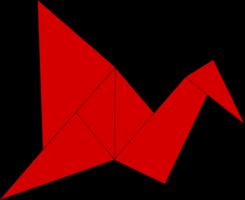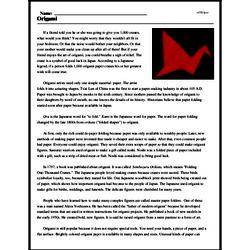Origami
If a friend told you he or she was going to give you 1,000 cranes, what would you think? You might worry that they wouldn't all fit in your bedroom. Or that the noise would bother your neighbors. Or that your mother would make you clean up after all of them! But if your friend enjoys the art of origami, you could breathe a sigh of relief. The crane is a symbol of good luck in Japan. According to a Japanese legend, if a person folds 1,000 origami paper cranes his or her greatest wish will come true.
Origami artists need only one simple material: paper. The artist folds it into amazing shapes. Ts'ai Lun of China was the first to start a paper-making industry in about 105 A.D. Paper was brought to Japan by monks in the sixth century. Since mothers passed the knowledge of origami to their daughters by word of mouth, no one knows the details of its history. Historians believe that paper folding started soon after paper became available in Japan.
Oru is the Japanese word for "to fold." Kami is the Japanese word for paper. The word for paper folding changed by the late 1800s from orikata ("folded shapes") to origami.




